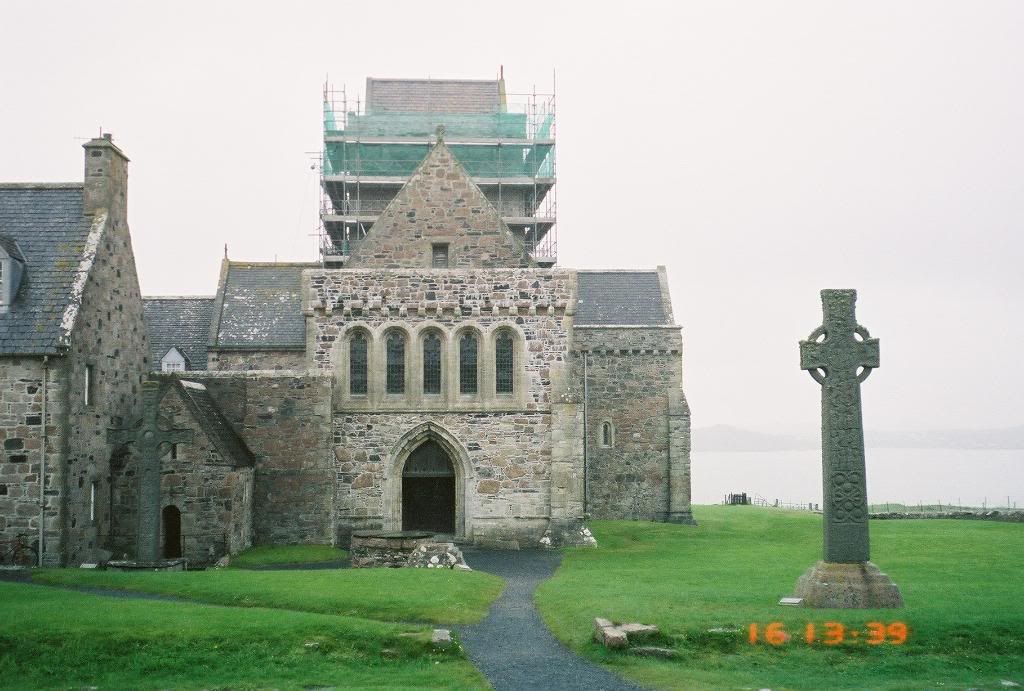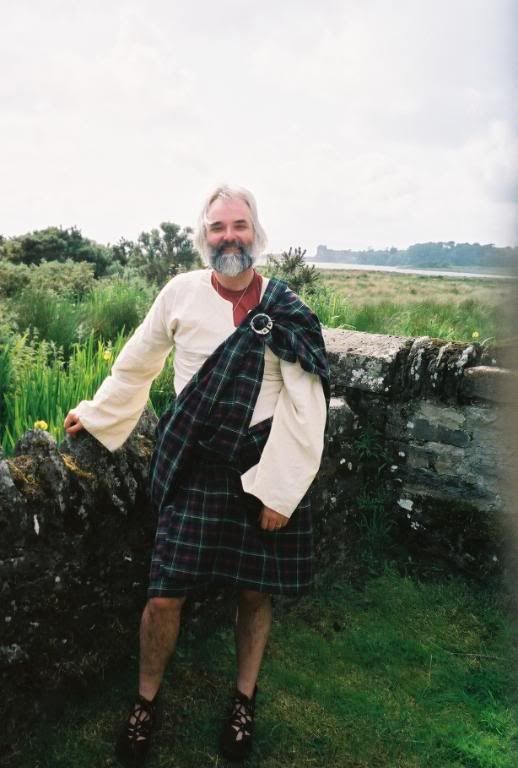|
-
It’s St. Columba Day!
Today, June 9th is the feast Day of St. Columba. He is a lesser known Saint of Ireland, i.e., St. Patrick and Scotland, i.e., St. Andrew but a very important one in the history of both countries.
So to each of you a very happy St. Columba Day!

Celtic Cross at St. Columba’s birth site Garten, Donegal Ireland

Iona Abbey - site of St. Columba's monastery in Scotland

Crew of the Colmcille at St. Columba's Foot Print at Southend, Kintyre on St. Columba's Day 2003.

On Duntrune Castle estate home of Chief Robin Malcolm of the MacCallum Malcolm Clan
More pix to come on this St. Columba Day!
Last edited by Mael Coluim; 9th June 09 at 07:44 PM.
-
-
Yes ! Good and happy st Columba day !
You know that in the representation of the Coat of Arms of Clan Donnachaidh, the Supporters has on peace (left) side, a green serpent with a red ribbon around its neck, and, on the war (right) side, a silver dove with a blue beak and a blue hat trimmed with ermine on its head.
The Serpent and Dove identify the Clan as being descended from Saint Columba and represent a pun on his name, ESTO PRUDENS UT SERPENS ET SIMPLEX SICUT COLUMBA.
This is his life :
Saint Columba (7 December 521 – 9 June 597), also known as Colum Cille (meaning "Dove of the church") was an outstanding figure among the Gaelic missionary monks who, some of his advocates claim, introduced Christianity to the Picts during the Early Medieval Period. He was one of the Twelve Apostles of Ireland.
Columba was born to Fedlimid and Eithne of the Cenel Conaill in Gartan, near Lough Gartan, County Donegal, in Ireland. On his father's side he was great-great-grandson of Niall of the Nine Hostages, an Irish high king of the 5th century.
In early Christian Ireland the druidic tradition collapsed due to the spread of the new Christian faith. The study of Latin learning and Christian theology in monasteries flourished. Columba became a pupil at the monastic school at Clonard Abbey, situated on the River Boyne in modern County Meath. During the sixth century, some of the most significant names in the history of Irish Christianity studied at the Clonard monastery. It is said that the average number of scholars under instruction at Clonard was 3,000. Twelve students who studied under St. Finian became known as the Twelve Apostles of Ireland, Columba was one of these. He became a monk and was ordained as a priest.
Tradition asserts that, sometime around 560, he became involved in a quarrel with Saint Finnian of Moville over a psalter. Columba copied the manuscript at the scriptorium under Saint Finnian, intending to keep the copy. Saint Finnian disputed his right to keep the copy. The dispute eventually led to the pitched Battle of Cúl Dreimhne in 561, during which many men were killed. A synod of clerics and scholars threatened to excommunicate him for these deaths, but St. Brendan of Birr spoke on his behalf with the result that he was allowed to go into exile instead. Columba suggested that he would work as a missionary in Scotland to help convert as many people as had been killed in the battle. He exiled himself from Ireland, to return only once again, several years later.
Columba's copy of the psalter has been traditionally associated with the Cathach of St. Columba.
In 563 he travelled to Scotland with twelve companions, where according to his legend he first landed at the southern tip of the Kintyre peninsula, near Southend. However, being still in sight of his native land he moved further north up the west coast of Scotland. In 563 he was granted land on the island of Iona off the west coast of Scotland which became the centre of his evangelising mission to the Picts. However, there is a sense in which he was not leaving his native people, as the Irish Gaels had been colonizing the west coast of Scotland for the previous couple of centuries. Aside from the services he provided guiding the only centre of literacy in the region, his reputation as a holy man led to his role as a diplomat among the tribes; there are also many stories of miracles which he performed during his work to convert the Picts. He visited the pagan king Bridei, king of Fortriu, at his base in Inverness, winning the king's respect, although not his conversion. He subsequently played a major role in the politics of the country. He was also very energetic in his evangelical work, and, in addition to founding several churches in the Hebrides, he worked to turn his monastery at Iona into a school for missionaries. He was a renowned man of letters, having written several hymns and being credited with having transcribed 300 books. One of the few, if not the only, times he left Scotland after his arrival was toward the end of his life, when he returned to Ireland to found the monastery at Durrow. He died on Iona and was buried in the abbey he created.
Several islands are named after Columba in Scotland, including Ì Chaluim Chille (one of the Scottish Gaelic names of Iona), Inchcolm and Eilean Chaluim Chille
Columba is credited as being a leading figure in the revitalization of monasticism, and "[h]is achievements illustrated the importance of the Celtic church in bringing a revival of Christianity to Western Europe after the fall of the Roman Empire". It is said Clan Robertson are heirs of Columba. Clan MacKinnon may also have some claim to being descendant of St Columcille as after he founded his Church on Isle Iona, The MacKinnons were the abbotts to the Church for centuries. This would also account for the fact that Clan MacKinnon is among the ancient clans of Scotland.
The Parish of Saint Columbkille serves the neighborhood of Brighton, MA with a church and grammar school. The current church was built to be the Cathedral of the Roman Catholic Archdiocese of Boston since it is in the same neighborhood as the former Cardinal's residence, but does not serve in this function. Papillion, Nebraska also has a church and grammar school named after Saint Columbkille.
Today, Aer Lingus, Ireland's national flag carrier has named one of its A330 aircraft in commoration of the saint (reg: EI-DUO).
The main source of information about Columba's life is the Vita Columbae by Adomnán (also known as Eunan), the ninth Abbot of Iona, who died in 704. Both the Vita Columbae and Bede record Columba's visit to Bridei. Whereas Adomnán just tells us that Columba visited Bridei, Bede relates a later, perhaps Pictish tradition, whereby the saint actually converts the Pictish king. Another early source is a poem in praise of Columba, most probably commissioned by Columba's kinsman, the king of the Uí Néill clan. It was almost certainly written within three or four years of Columba's death and is the earliest vernacular poem in European history. It consists of 25 stanzas of four verses of seven syllables each.
The vita of Columba is also the source of the first known reference to a Loch Ness Monster. According to Adomnan, Columba came across a group of Picts who were burying a "poor little man"[5] who had been killed by the monster, and saved a swimmer with the sign of the Cross and the imprecation "You will go no further", at which the beast fled terrified, to the amazement of the assembled Picts who glorified Columba's God. Whether or not this incident is true, Adomnan's text specifically states that the monster was swimming in the River Ness - the river flowing from the loch - rather than in Loch Ness itself.
Through the reputation of its venerable founder and its position as a major European centre of learning, Columba's Iona became a place of pilgrimage. A network of Celtic high crosses marking processional routes developed around his shrine at Iona.
Columba is historically revered as a warrior saint, and was often invoked for victory in battle. His relics were finally removed in 849 and divided between Alba and Ireland. Relics of Columba were carried before Scottish armies in the reliquary made at Iona in the mid-8th century, called the Brecbennoch. Legend has it that the Brecbennoch, was carried to Bannockburn by the vastly outnumbered Scots army and the intercession of the Saint helped them to victory. It is widely thought that the Monymusk Reliquary is this object.
O Columba spes Scotorum... "O Columba, hope of the Scots" begins a 13th century prayer in the Antiphoner of Inchcolm, the "Iona of the East".

-
-
 Originally Posted by Rollo

Yes ! Good and happy st Columba day !
You know that in the representation of the Coat of Arms of Clan Donnachaidh, the Supporters has on peace (left) side, a green serpent with a red ribbon around its neck, and, on the war (right) side, a silver dove with a blue beak and a blue hat trimmed with ermine on its head.
You mean the dexter and sinister sides, don't you? I've never heard them referred to as "war and peace."
-
-
Fascinating post, Rollo, thank you!!
-
-
It's a little known fact that the "C" in my name stands for "Columba" -- my confirmation saint!
What better way to mark the day than to wear the St. Columba tartan!

-
-
Thanks for the reminder, it sure crept up on me, yet the pictures inspired.
Glen McGuire
A Life Lived in Fear, Is a Life Half Lived.
-
-
I like these posts, great stuff.
The photos are stunning.
Glad we have great people sutch as Mael Coluim and Rollo
who makes this forum what it is.
Thanks for the history of St Columba.
-
-
Thank you Rollo for that post. I continue to learn each day here at XMarks and I love it.
That picture and Kilt are just absolute grand, as are the photos of the St Columba Celtic Cross and Monastery.
I don't believe the idea is to arrive in heaven in a well preserved body! But to slide in side ways,Kilt A' Fly'n! Scream'en "Mon Wha A Ride" Kilted Santas
4th Laird of Lochaber, Knights of St Andrew,Knight of The Double Eagle
Clan Seton,House of Gordon,Clan Claus,Semper Fedilas
-
-
i went to columba high catholic school as a lad here in coatbridge so all the best on this day ,its a shame the old school got tore down though for the modern st andrews high
-
-
9th June 09, 04:55 AM
#10
Cool thanks for the info and pics.
-
Similar Threads
-
By Mael Coluim in forum Virginia
Replies: 7
Last Post: 6th June 09, 01:05 PM
-
By Mael Coluim in forum Miscellaneous Forum
Replies: 1
Last Post: 9th June 08, 03:44 AM
-
By Mael Coluim in forum General Kilt Talk
Replies: 38
Last Post: 21st January 08, 01:45 PM
Tags for this Thread
 Posting Permissions
Posting Permissions
- You may not post new threads
- You may not post replies
- You may not post attachments
- You may not edit your posts
-
Forum Rules
|
|


























Bookmarks